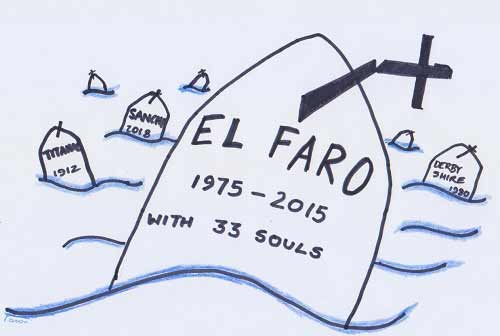'All accidents are, at some level of the other, failures of leadership at sea'
-Golden Stripes - Leadership on the High Seas
My heartfelt condolences to the families of the 33 men and women who lost their lives on the El Faro on 1st October 2015.
This article to share the last lessons we can gather from this tragedy, and in doing so honour their memory. No one is perfect, though we can aim to be a better version of ourselves- for the sake of our own safety, and of those who depend on us. We all make mistakes, and each mistake is an opportunity to learn. Unfortunately, many of these lessons come at a cost- lives in this case.
The El Faro was on a voyage from Jacksonville to San Juan with the hurricane Joaquin in its path. The Captain had a choice of alternate routes to avoid the storm. The 2nd Mate who had signed off the ship some days ago, had the extraordinary presence of mind to alert the Captain of the developing storm, and sent another text message to remind him of the alternate routes through the Old Bahama Channel. The Captain however, made a unilateral decision to continue his normal, shortest route to San Juan. It was a failure of decision making- though the Master had earlier undergone the STCW Leadership and Management Course just six months earlier, decision-making being one of the topics.
The DPA was on vacation and the deputy was not asked to step in his shoes. Thus, there was no oversight on the ship's operational safety matters, particularly in regard to voyage planning. This was a failure in planning for continuity of operations.
The ship's Safety Management System did not have a heavy weather procedure, plan or checklist- which is a failure in safety leadership and in risk management. This was probably one of the reasons the main engine lube oil sump was not topped up, contrary to usual marine engineering practice. When the ship listed to port and trimmed by the head, the lube oil pump lost suction- tripping the main engine at a critical time. This was a deadly blow to the ship which was already close to the eye of the hurricane and it lost control in the face of wind speeds exceeding 100 knots.
The El Faro is one of the latest in a long line of maritime accidents, unfortunately involving fatalities. There are lessons in leadership to prevent future accidents.

In an unrelated incident on the El Faro months earlier, the previous Chief Mate was found sleeping on watch on numerous occasions- but the Masters did not alert the DPA about it. It was finally when another crew member brought it to the attention of the shore management, the issue was dealt with. Perhaps this points to the lack of reinforcement of discipline and procedures which also flowed into other areas of operation - the ventilators for the car-decks were not bolted shut- these ultimately gave way, leading to progressive flooding of the cargo spaces. A failure to ensure this critical procedure, especially when expecting heavy weather was a failure of team leadership.
The other watchkeepers raised their concern about the direct route to San Juan but the Captain did not review his decision. The sad part is that this is not the first such accident. I wrote about the Green Lily foundering in heavy weather in Golden Stripes, which was before the El Faro incident. The various failures of leadership remain the same as I describe throughout the book- only the names of ships and people change. When are we going to learn?
There are more lessons about failures on organizational levels from the US Coast Guard's detailed investigation report, which I will share in another article. But I wonder if there were more reasons why the Captain chose a route dangerously close to the eye of the storm. The SVDR transcript reveals the Master and few of his officers were concerned about not getting a position on ships that were being built to potentially replace the El Faro. The Captain had to leave his previous company because he had ordered extra tugs for a port manoeuvre. Probably it was an attempt to prove his performance as a Master and secure his re-employment. Or was it just a rash decision the Captain made without consulting his team? Either way, this tragedy was a failure of leadership on various levels.
In closing, I ask you to think about the following questions:
* How are we enabling those who we lead, for them to lead better, and make better decisions?
* How are we encouraging a culture of effective, practical leadership?
* The answers will determine how safe the ships and the mariners are, in a ruthless environment as the sea.
References:
The US Coast Guard Report on the El Faro


